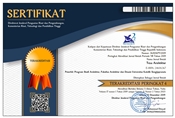POLA AKTIVITAS WISATA BELANJA DI KAMPUNG WISATA KERAMIK DINOYO, MALANG (Activity Pattern of Shopping Tourism in Dinoyo Ceramics Tourism Kampong, Malang)
Abstract
Keywords
Full Text:
PDFReferences
Bentley, Ian et al. 1985. Responsive Environment, a Manual for Designers. London: Routledge.
Dewi, Aryanti, Antariksa, dan San Soesanto. 2005. Pengaruh Kegiatan Berdagang Terhadap Pola Ruang-Dalam Bangunan Rumah-Toko di Kawasan Pecinan Kota Malang. Dimensi (Jurnal Teknik Arsitektur), vol. 33, no. 1, 17-26.
El Demery, Ibrahim Mostafa. 2010. Sustainable Architectural Design: Reviving Traditional Design and Adapting Modern Solution. Archnet-Ijar International Journal of Architectural Research, vol. 4, issue 1, 99-110.
Firmansyah, R. 2010. Analisis Usaha Pengrajin dalam Upaya Mempertahankan Keberlangsungan Industri Kecil Keramik. skripsi. tidak dipublikasikan. Malang: Jurusan Ekonomi Pembangunan, Fakultas Ekonomi, Universitas Negeri Malang.
Gehl, Jan. 1987. Life Between Buildings: Using Public Space, terjemahan Jo Koch, New York: Van Nostrand Reinhold.
Lang, Jon. 1987. The Built Environment Social Behavior: Architecture Determinism Rexamined Viair. Cambridge, MA: The Wit Press.
Murtini, Titien Woro. 2011. Peran Perempuan dalam Pemanfaatan Ruang pada Rumah Tinggal sebagai Ruang Ekonomi. Jurnal Ilmiah Perancangan Kota dan Permukiman, vol. 10, no. 1, 41-53.
Soegiono, Bagus Soeprijono. 2011. Transformasi Penggunaan Ruang Hunian Akibat Usaha Berbasis Rumah Tangga. tesis. Surabaya: Institut Teknologi 10 November Surabaya.
Taufikurrahman. 2010. Perubahan Pola Tatanan Ruang Rumah Tinggal sebagai Akibat Kegiatan Industri Rumah Tangga (Studi Kasus: Pengrajim Logam di Desa Ngingas Kecamatan Waru Sidoarjo). tesis. Surabaya: Institut Teknologi 10 November Surabaya.
Tomory, Mihaly. 2006. Investigating Shopping Tourism Along the Borders of Hungary a Theoretical Perspective. Geojournal of Tourism and Geosites, vol. 6, no. 2, 202-210.
Santoso, Joko Triwinarto et al. 2012. Model Penataan Ruang Rumah Produktif untuk Peningkatan Kegiatan Ekonomi Industri Keramik Rakyat di Dinoyo, Malang. laporan penelitian. tidak dipublikasikan. Malang: Universitas Brawijaya.
DOI: https://doi.org/10.24167/tesa.v14i1.560
ISSN 1410-6094 (Print) | ISSN 2460-6367 (Media Online) | View My Stats

This work is licensed under a Creative Commons Attribution 4.0 International License.








